Evaluation of Applicability of Minimum Required Compressive Strength for Cold Weather Concreting Based on Winter Meteorological Factors
Abstract
1. Introduction
2. Summary of Current Regulation Content about Minimum Required Compressive Strength of Various Countries
3. Experimental Program and Estimation Plan
3.1. Experimental Materials and Mix Proportions
3.2. Pre-Experiment and Main Experiments
3.2.1. Pre-Experiment
3.2.2. Main Experiments
3.3. Test Methods
3.3.1. Fresh Properties
3.3.2. Hydration Degree Test
3.3.3. Underwater Weighing Test
3.3.4. Compressive Strength Test
3.3.5. Freeze–Thaw Test
3.4. Estimation Based on Meteorological Factors
3.4.1. Selection of Meteorological Data of Cold Regions and Period
3.4.2. Estimation Method
4. Results and Discussions
4.1. Pre-Experiment
4.2. Main Experiments
4.2.1. Fresh Concrete
4.2.2. Compressive Strength
4.2.3. Hydration Degree and Total Porosity
4.2.4. Frost Resistance of Concrete
4.3. Estimation Based on Winter Meteorological Factors
5. Conclusions
- Air-entrained concrete that reaches a compressive strength of 5.0 MPa can withstand several freeze–thaw cycles and effectively prevent early age frost damage.
- Recovery curing significantly improves the compressive strength and frost resistance of early frozen concrete. It can make frozen concrete attain normal strength development and achieve the same degree of frost resistance as non-frozen concrete.
- For early age concrete subjected to repeated freeze–thaw cycles in a critical water-saturated environment, the frost resistance increases with the increase in compressive strength. For OPC concrete with w/c of 0.5, the numbers of freeze–thaw cycles of the concrete with compressive strength values of 5.0, 12.0, 18.0, and 25.0 MPa that can maintain the relative dynamic modulus of elasticity above 90% were about 18, 55, 90, and 124 cycles, respectively.
- Using winter meteorological factors from various locations to estimate shows that 5.0 MPa as the minimum required compressive strength for cold weather concreting is sufficient to protect concrete from early age frost damage. For concrete constructions under critical water-saturated environments, from the viewpoint of concrete quality management, it is necessary to use a compressive strength value greater than 5.0 MPa.
Author Contributions
Funding
Institutional Review Board Statement
Informed Consent Statement
Data Availability Statement
Conflicts of Interest
References
- Recommendation for Practice of Cold Weather Concreting; Architectural Institute of Japan: Tokyo, Japan, 2010. (In Japanese)
- Japanese Architectural Standard Specification JASS 5 Reinforced Concrete Work; Architectural Institute of Japan: Tokyo, Japan, 2018.
- Kim, M.; Yokoyama, T.; Tabata, M.; Koh, Y.; Kamada, E. An experimental study on the effect of air entrainment for frost resistance of concrete at an early age. Archit. Inst. Jpn. 1978, 265, 1–10. (In Japanese) [Google Scholar] [CrossRef][Green Version]
- Nmai, C.K. Cold weather concreting admixtures. Cem. Concr. Compos. 1988, 20, 121–128. [Google Scholar] [CrossRef]
- Hama, Y.; Kamada, E. Strength development under freezing conditions and freezing behavior of water in concrete with accerelatores for freeze protection. Concr. Res. Technol. 1997, 8, 73–80. (In Japanese) [Google Scholar] [CrossRef] [PubMed][Green Version]
- Demirboga, R.; Karagöl, F.; Polat, R.; Kaygusuz, M.A. The effects of urea on strength gaining of fresh concrete under the cold weather conditions. Constr. Build. Mater. 2014, 64, 114–120. [Google Scholar] [CrossRef]
- Karagol, F.; Demirboga, R.; Khushefati, W.H. Behavior of fresh and hardened concretes with antifreeze admixtures in deep-freeze low temperatures and exterior winter conditions. Constr. Build. Mater. 2015, 76, 388–395. [Google Scholar] [CrossRef]
- Qin, X.C.; Meng, S.P.; Cao, D.F.; Tu, Y.M.; Sabourova, N.; Grip, N.; Ohlsson, U.; Blanksvärd, T.; Sas, G.; Elfgren, L. Evaluation of freeze-thaw damage on concrete material and prestressed concrete specimens. Constr. Build. Mater. 2016, 125, 892–904. [Google Scholar] [CrossRef]
- Cao, D.F.; Qin, X.C.; Meng, S.P.; Tu, Y.M.; Elfgren, L.; Sabourova, N.; Grip, N.; Ohlsson, U.; Blanksvärd, T. Evaluation of prestress losses in prestressed concrete specimens subjected to freeze–thaw cycles. Struct. Infrastruct. Eng. 2016, 12, 159–170. [Google Scholar] [CrossRef]
- Zhang, G.; Yu, H.; Li, H.; Yang, Y. Experimental study of deformation of early age concrete suffering from frost damage. Constr. Build. Mater. 2019, 215, 410–421. [Google Scholar] [CrossRef]
- Powers, T.C. Prevention of frost damage to green concrete. RILEM Bull. 1962, 14, 120–124. [Google Scholar]
- George, C.H.; Alan, D.B. Considerations in the prevention of damage to concrete frozen at early ages. J. Am. Concr. Inst. 1983, 80, 371–376. [Google Scholar]
- Moller, G. Tests of resistance of concrete to early frost action. In RILEM Symposium on Winter Concreting, Theory and Practice; Session B-1; RILEM: Copenhagen, Denmark, 1956; p. 31. [Google Scholar]
- Yi, S.; Pae, S.; Kim, J. Minimum curing time prediction of early-age concrete to prevent frost damage. Constr. Build. Mater. 2011, 25, 1439–1449. [Google Scholar] [CrossRef]
- Koh, Y. A Study on Winter Construction of Concrete in Hokkaido. Ph.D. Thesis, Hokkaido University, Hokkaido, Japan, 1959. (In Japanese). [Google Scholar]
- Recommended Practice for Cold Weather Concreting; American Concrete Institute Committee 306-66; American Concrete Institute: Farmington Hills, MI, USA, 1966.
- Recommendations for Winter Concreting; RILEM Bulletin No. 21; Winter Construction Committee, RILEM: Copenhagen, Denmark, 1963.
- Voellmy, A. High Concrete Quality in Cold Weather. In RILEM Symposium on Winter Concreting; Session D; RILEM: Copenhagen, Denmark, 1956. [Google Scholar]
- Rastrup, E. Requirdening Time by Freezing of Green Concrete in Relation to the Cements; RILEM Bulletin No. 23; Recommendations for Winter Concreting; RILEM: Copenhagen, Denmark, 1964. [Google Scholar]
- Koh, K.T.; Park, C.J.; Ryu, G.S.; Park, J.J.; Kim, D.G.; Lee, J.H. An experimental investigation on minimum compressive strength of early age concrete to prevent frost damage for nuclear power plant structures in cold climates. Nucl. Eng. Technol. 2013, 45, 393–400. [Google Scholar] [CrossRef]
- Choi, H.; Zhang, W.; Hama, Y. Method for determining early-age frost damage of concrete by using air-permeability index and influence of early-age frost damage on concrete durability. Constr. Build. Mater. 2017, 153, 630–639. [Google Scholar] [CrossRef]
- Guide to Cold Weather Concreting; American Concrete Institute Committee 306; American Concrete Institute: Farmington Hills, MI, USA, 2016.
- C666/C666M-15; Standard Test Method for Resistance of Concrete to Rapid Freezing and Thawing. ASTM International: West Conshohocken, PA, USA, 2015.
- JIS A 1148; Method of Test for Resistance of Concrete to Freezing and Thawing. Japan Standards Association: Tokyo, Japan, 2010. (In Japanese)
- GB/T50082-2009; The Test Method of Long-Term and Durability on Ordinary Concrete. Industry Standard of the People’s Republic of China: Beijing, China, 2009. (In Chinese)
- Hasegawa, K.; Hon, E. Influence of External Factors on Frost Damage of Concrete and Frost Damage Risk in Japan; Research Report; Faculty of Engineering, Hokkaido University: Hokkaido, Japan, 1979. (In Japanese) [Google Scholar]
- Hama, Y.; Matsumura, K.; Tabata, M.; Tomiita, T.; Kamada, E. Estimation of frost damage of concrete based on meteorological factors. J. Struct. Constr. Eng. 1999, 523, 9–16. [Google Scholar] [CrossRef] [PubMed]
- Quy, N.X.; Noguchi, T.; Na, S.; Kim, J.; Hama, Y. Distribution map of frost resistance for cement-based materials based on pore structure change. Materials. 2020, 13, 2509. [Google Scholar] [CrossRef]
- Standard Specifications for Concrete Structures, Materials & Construction; Japan Society of Civil Engineers: Tokyo, Japan, 2017. (In Japanese)
- RILEM Recommendations for Concreting in Cold Weather; VTT Technical Research Centre of Finland: Espoo, Finland, 1988.
- Concrete Materials and Methods of Concrete Construction/Test Methods and Standard Practices for Concrete; Canadian Standards Association: Toronto, ON, Canada, 2014.
- Specification for Winter Construction of Building Engineering; Ministry of Housing and Urban-Rural Development of the People’s Republic of China: Beijing, China, 2011. (In Chinese)
- Recommendations for the Production of Concrete Work in Winter; Non-Profit Partnership Self-Regulatory Organization Union of Construction Companies of Ural and Siberia: Chelyabinsk, Russia, 2015. (In Russian)
- Concrete Standard Specification Ministry of Land; Infrastructure and Transport of South Korea: Seoul, Republic of Korea, 2016. (In Korean)
- Saul, A.G.A. Principles Underlying the Steam Curing of Concrete at Atmospheric Pressure; Magazine of Concrete Research: London, UK, 1951; Volume 2, pp. 127–140. [Google Scholar] [CrossRef]
- Koh, Y. Proposal of practical method for estimating concrete strength and its application (material/construction). Archit. Inst. Jpn. 1959, 63, 129–132. [Google Scholar] [CrossRef][Green Version]
- JIS A 1108; Method of Test for Compressive Strength of Concrete. Japan Standards Association: Tokyo, Japan, 2018. (In Japanese)
- JIS A 1101; Method of Test for Slump of Concrete. Japan Standards Association: Tokyo, Japan, 2020. (In Japanese)
- JIS A 1128; Method of Test for Air Concrete of Fresh Concrete by Pressure Method. Japan Standards Association: Tokyo, Japan, 2019. (In Japanese)
- JIS A 1156; Method of Measurement for Temperature of Fresh Concrete. Japan Standards Association: Tokyo, Japan, 2006. (In Japanese)
- Korpa, A.; Trettin, R. The Influence of Different Drying Methods on Cement Paste Microstructures as Reflected by Gas Adsorption: Comparison between Freeze-Drying (F-Drying), D-Drying, P-Drying and Oven-Drying Methods. Concr. Res. 2006, 36, 634–649. [Google Scholar] [CrossRef]
- Integrated Surface Dataset (Global). National Centers for Environmental Information of National Oceanic and Atmospheric Administration. Available online: https://www.ncei.noaa.gov/access/search/data-search/global-hourly (accessed on 5 October 2020).
- Yamashita, K. Mechanism of Strength Enhancement Stagnation of Concrete Subjected to Freezing during the Setting and Hardening Process and Measurement of the Extent and Depth of Frost Damage. Ph.D. Thesis, Muroran Institute of Technology, Hokkaido, Japan, 2021. (In Japanese). [Google Scholar] [CrossRef]
- Bai, S.; Guan, X.; Li, G. Effect of the early-age frost damage and nano-SiO2 modification on the properties of Portland cement paste. Constr. Build. Mater. 2020, 262, 120098. [Google Scholar] [CrossRef]
- Hu, X.; Peng, G.; Niu, D.; Zhao, N. Damage study on service performance of early-age frozen concrete. Constr. Build. Mater. 2019, 210, 22–31. [Google Scholar] [CrossRef]
- Liu, L.; Ye, G.; Schlangen, E.; Chen, H.; Qian, Z.; Sun, W.; Breugel, K.V. Modeling of the internal damage of saturated cement paste due to ice crystallization pressure during freezing. Cem. Concr. Compos. 2011, 33, 562–571. [Google Scholar] [CrossRef]
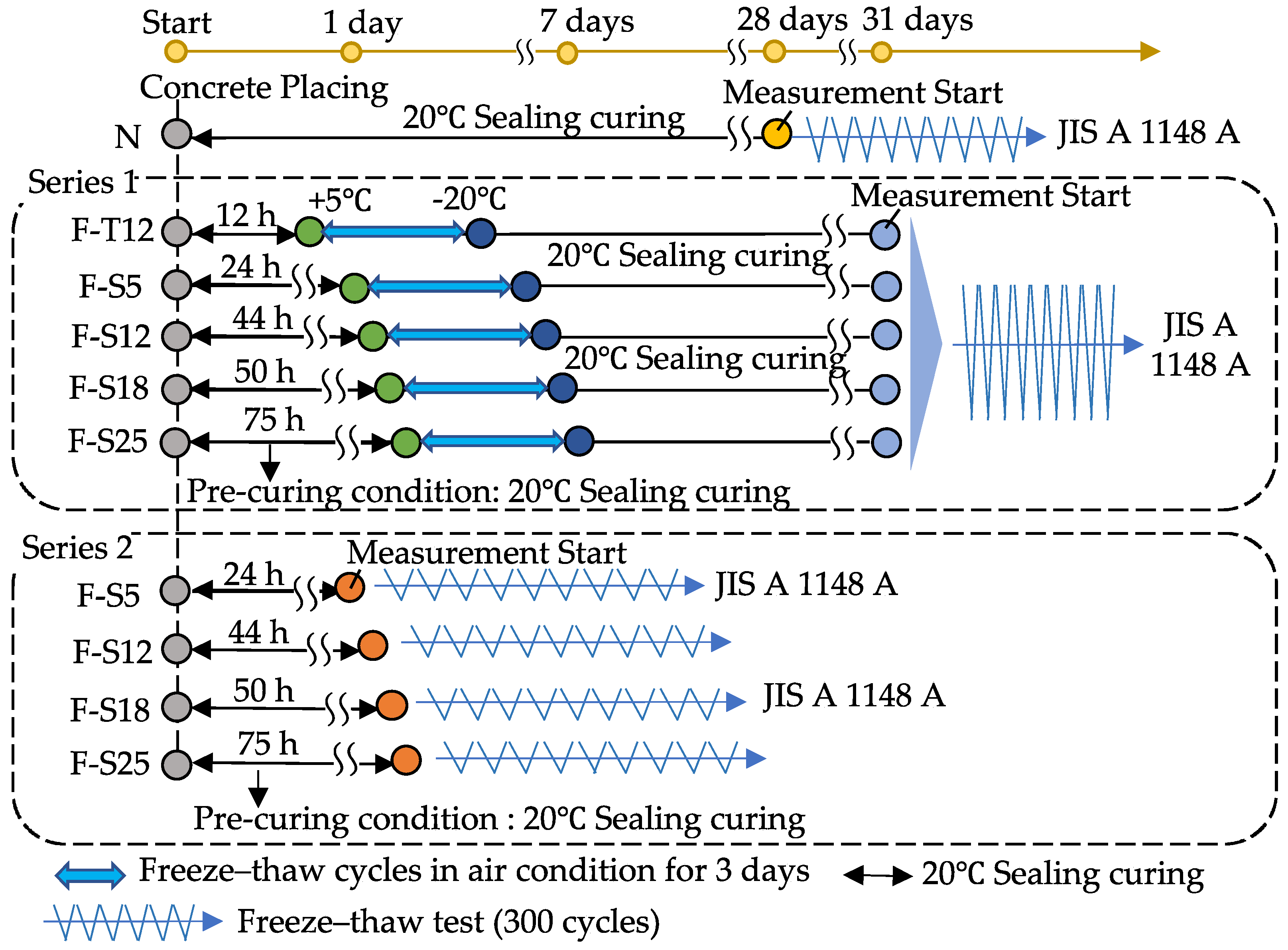
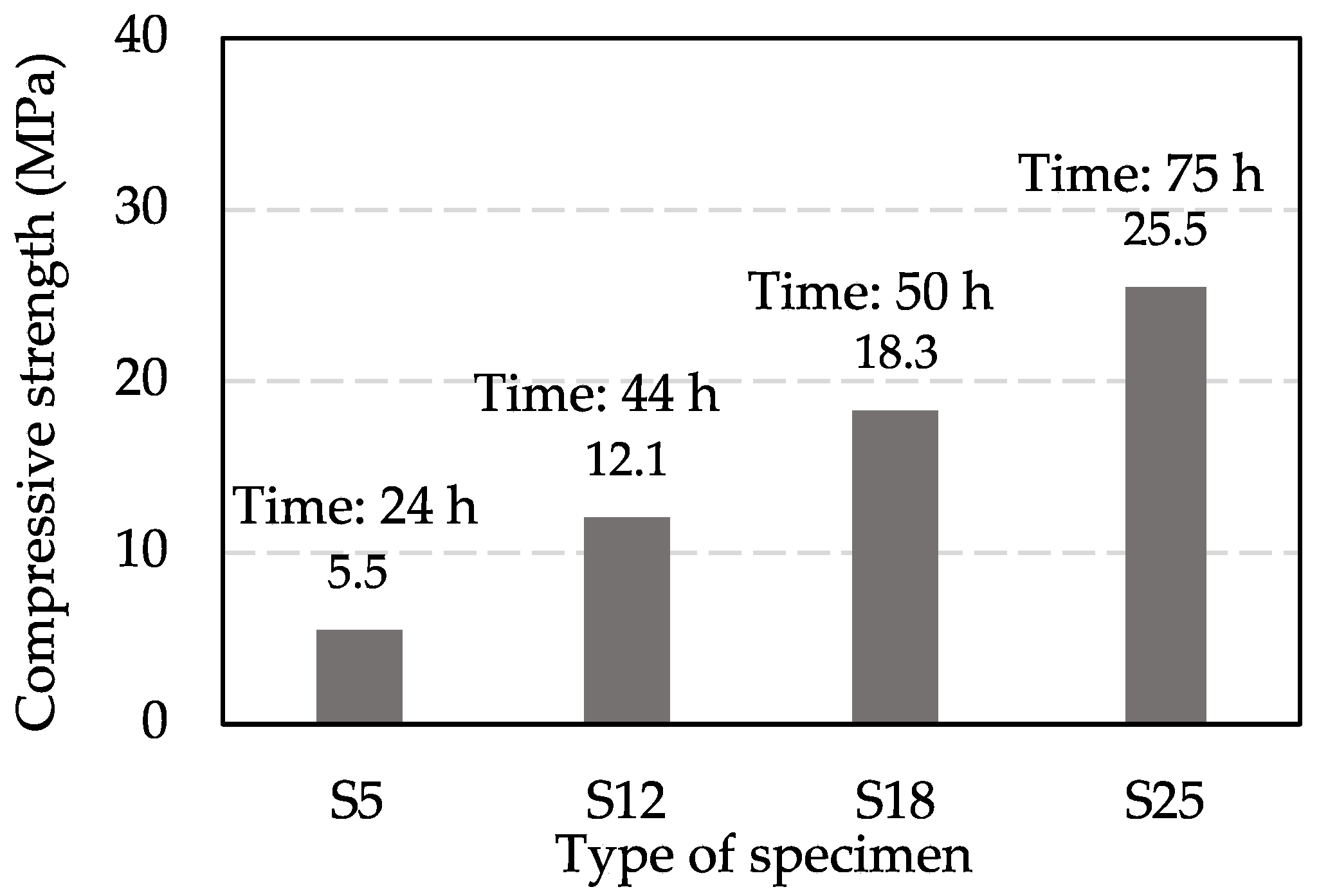
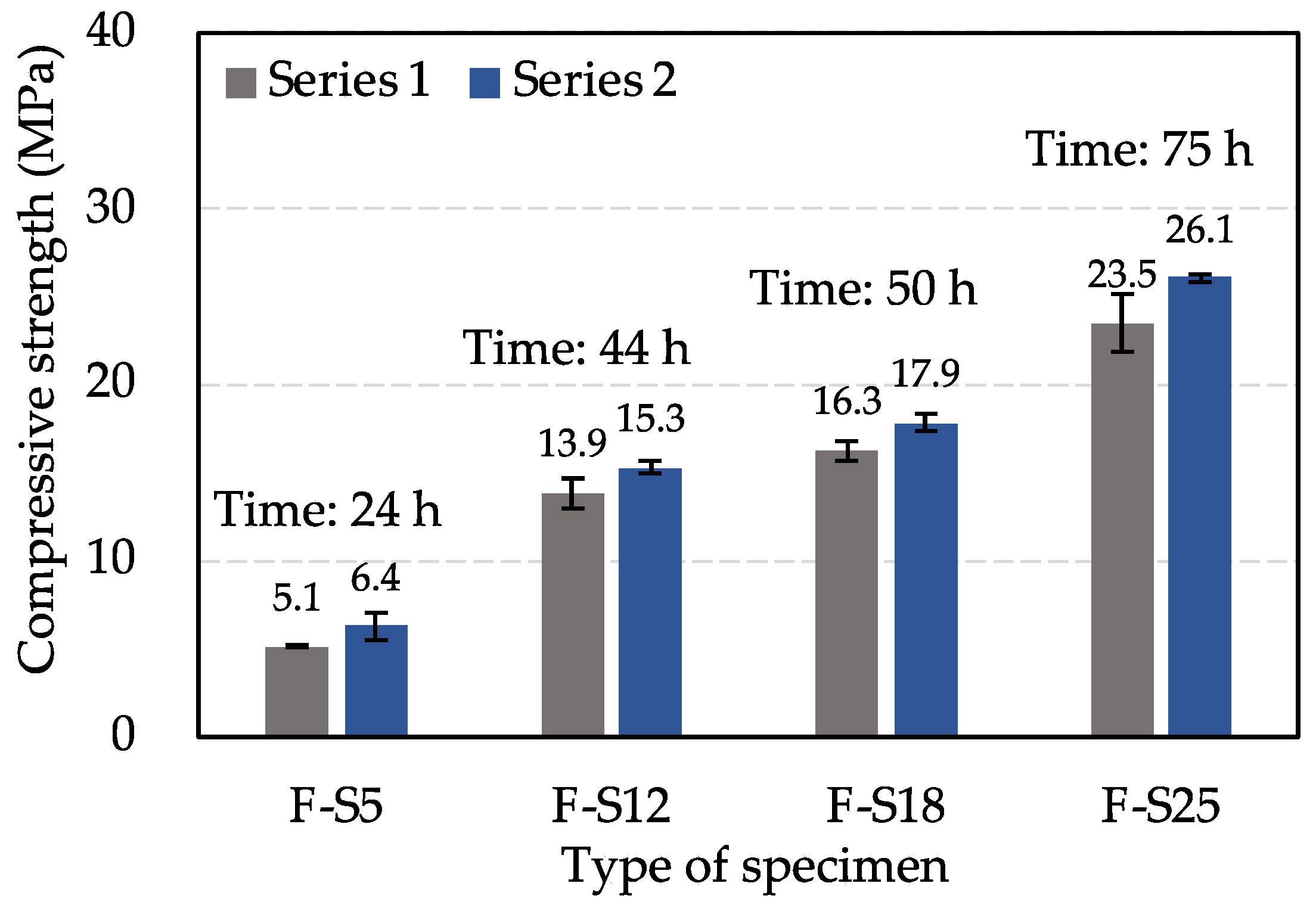
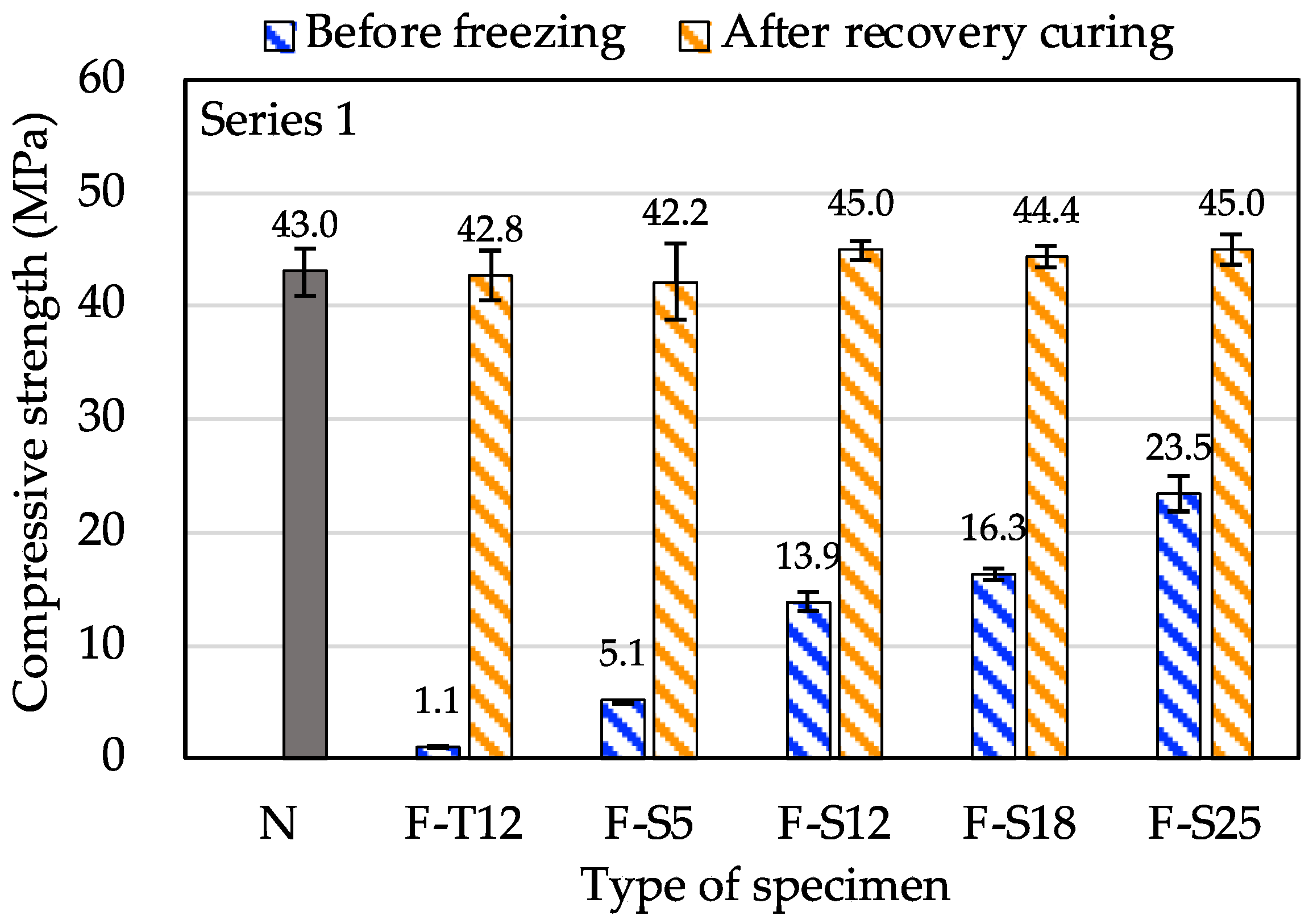
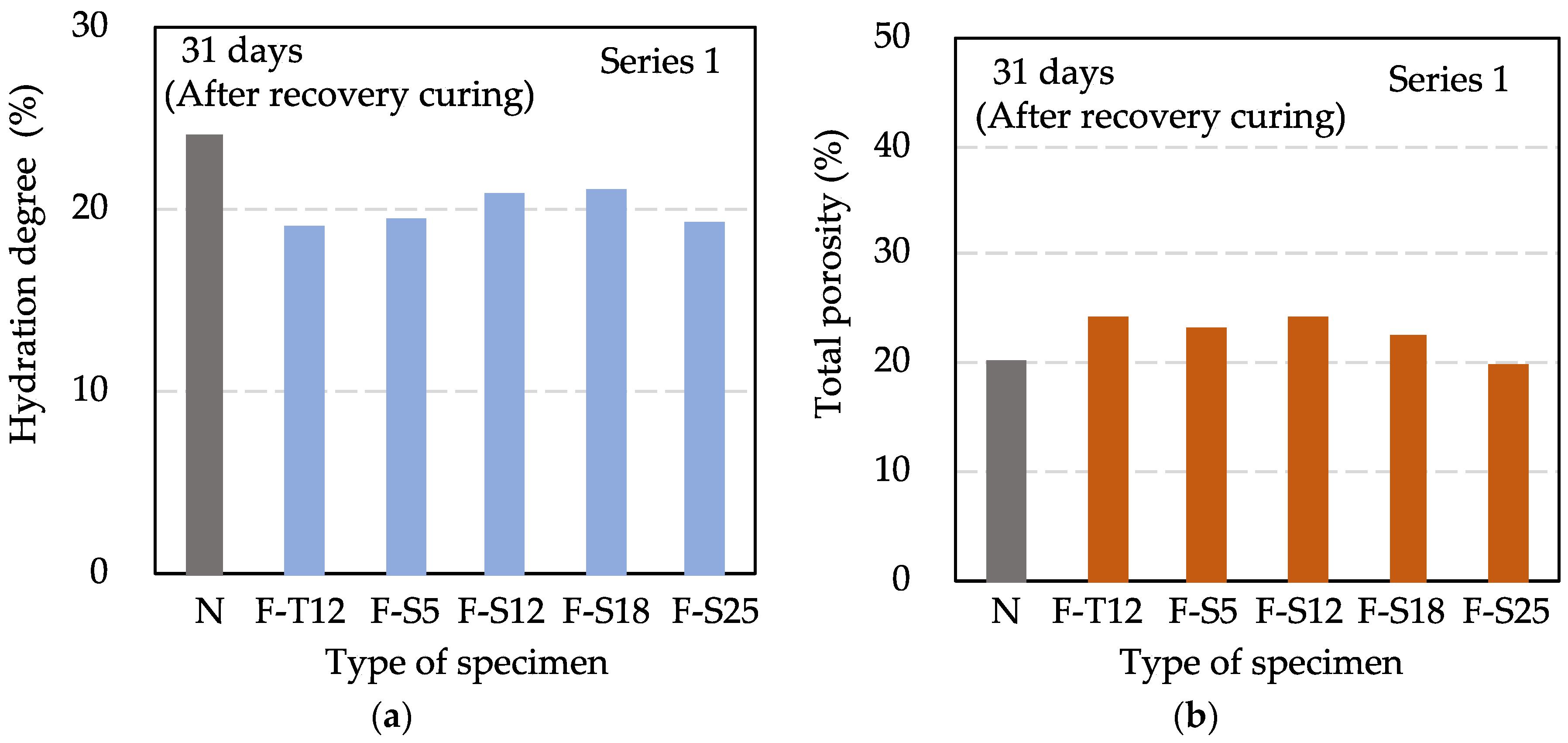
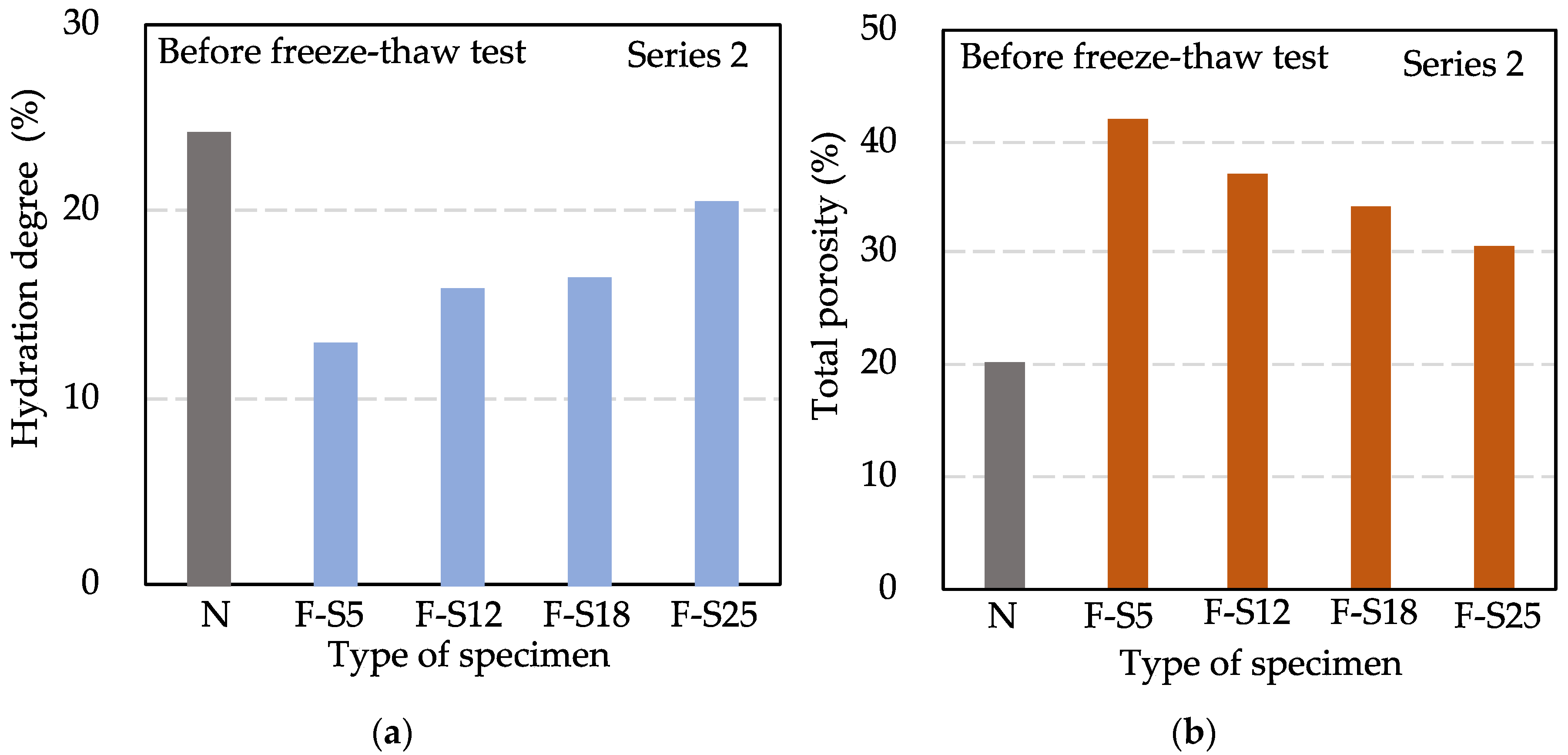
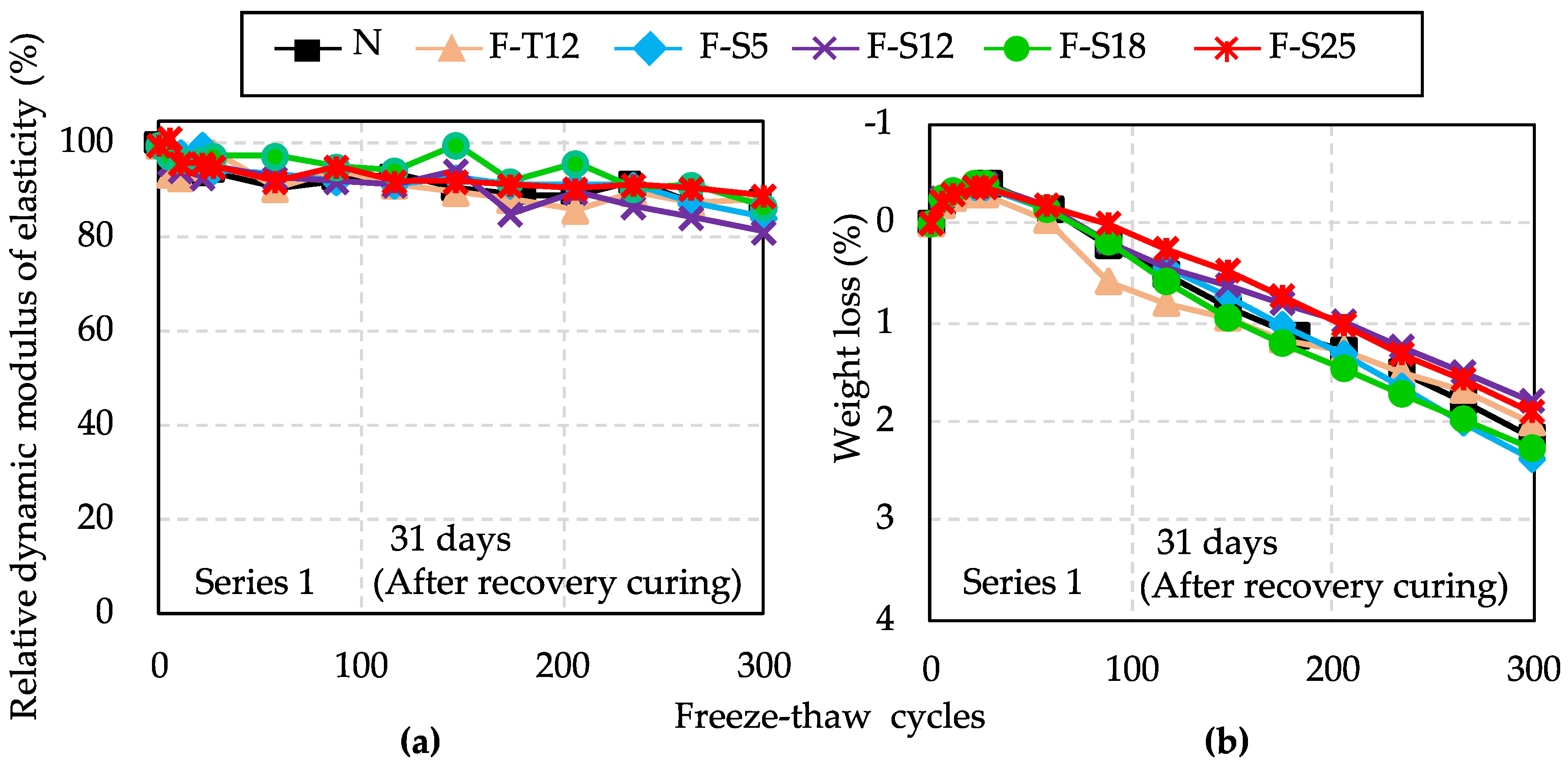

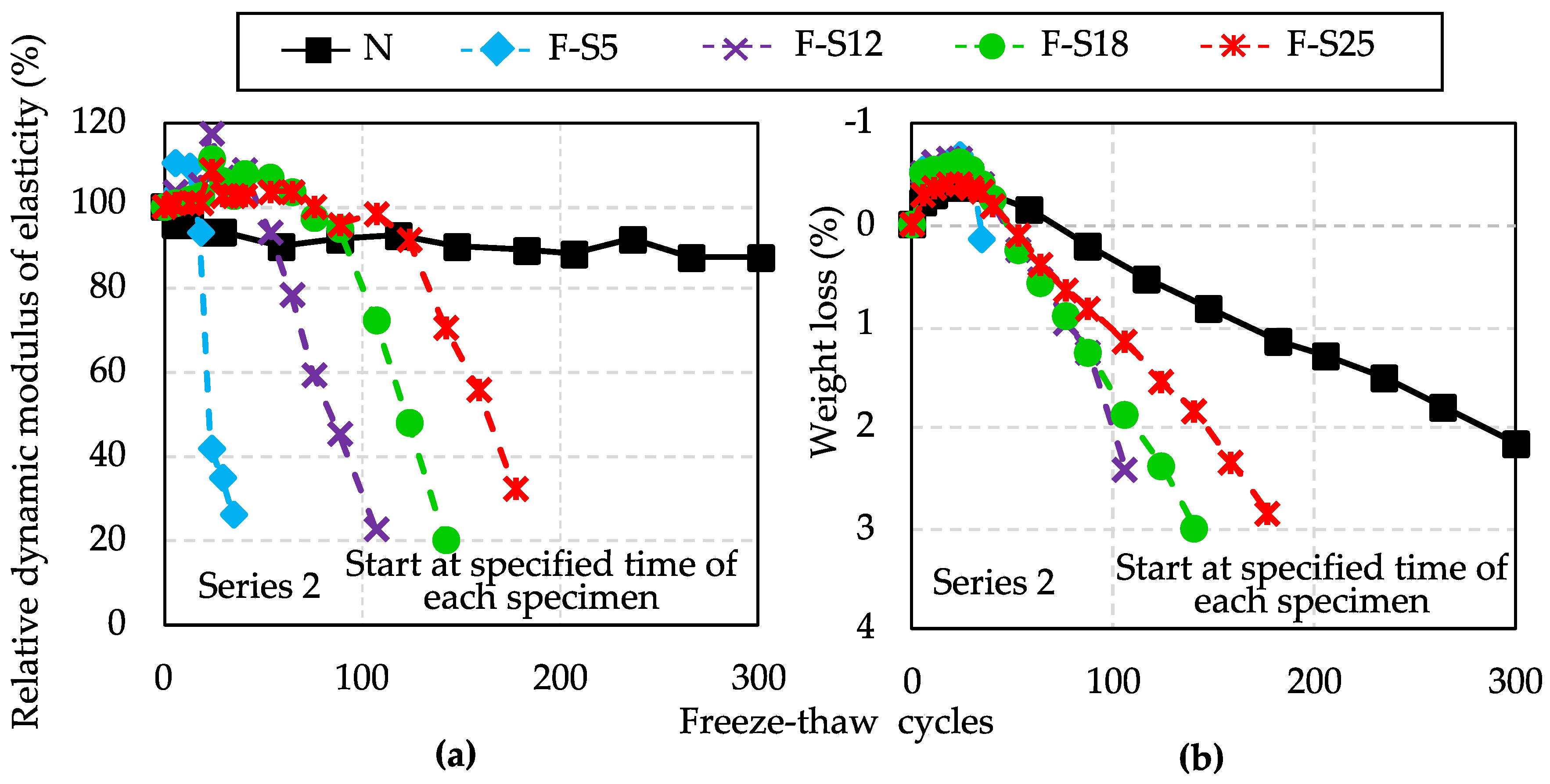
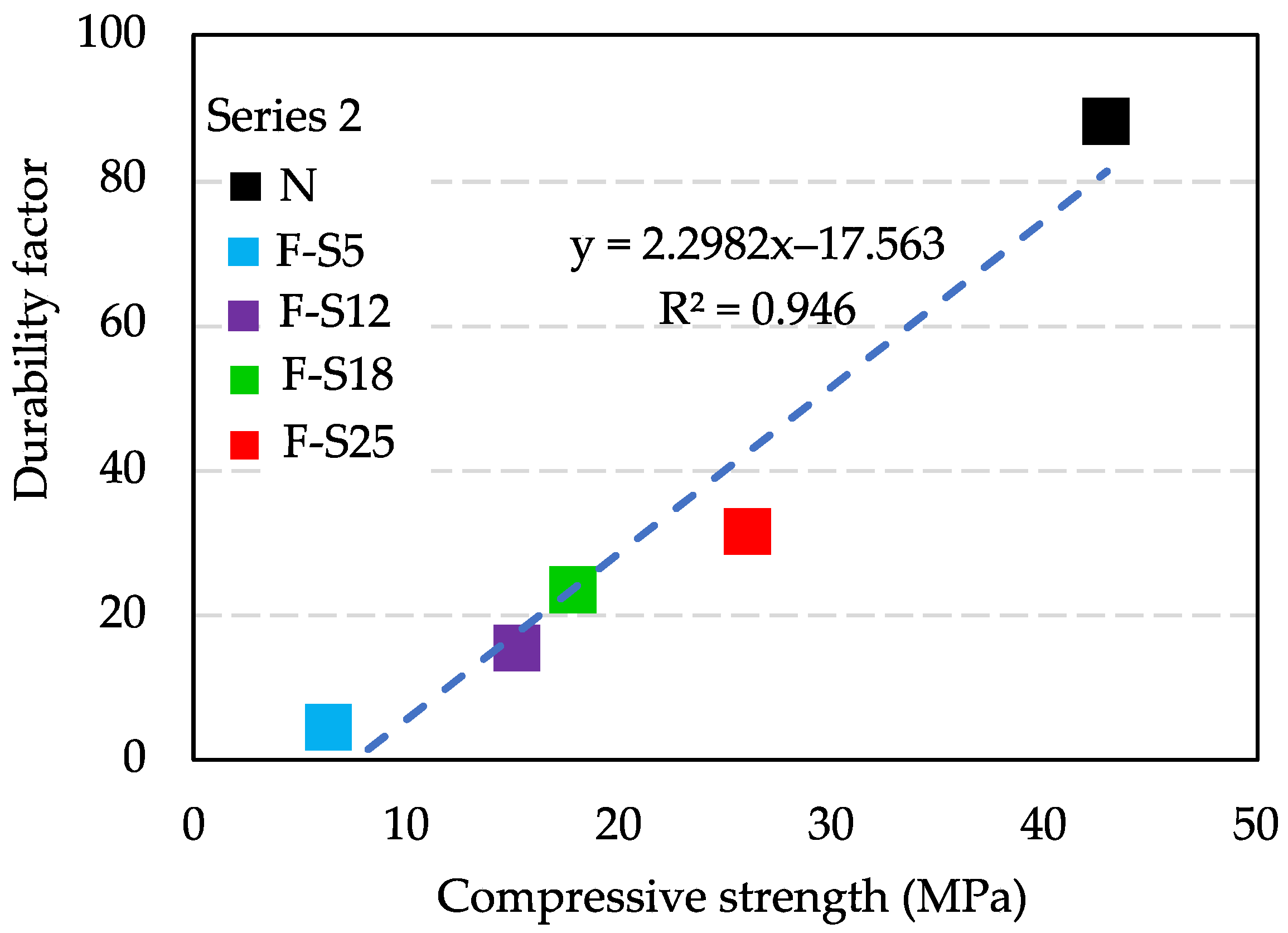
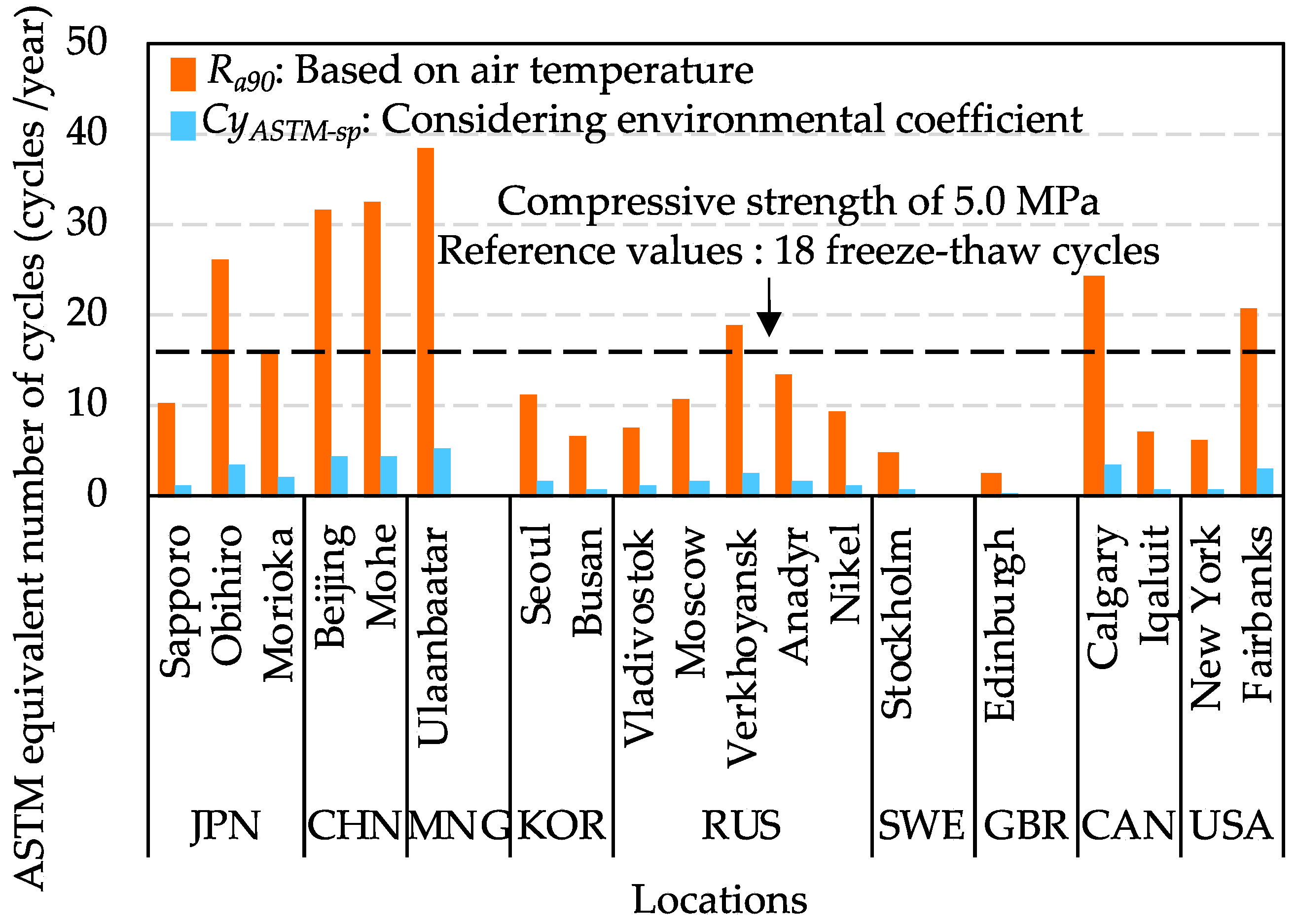
| Guides | Compressive Strength Values |
|---|---|
| RILEM recommendations for concreting in cold weather [30] (VTT Technical Research Centre of Finland, 1988) | 5.0 MPa |
| Guide to Cold Weather Concreting [22] (American Concrete Institute Committee 306, 2016) | (1) 3.5 MPa (2) When concrete exposed to repeated freeze–thaw cycles while critically saturated: more than 24.5 MPa |
| Concrete materials and methods of concrete construction/Test methods and standard practices for concrete [31] (Canadian Standards Association, 2014) | (1) 7.0 MPa (2) When exterior concrete flatwork exposed to freeze–thaw cycles and de-icer salts: at least 32.0 MPa |
| Recommendation for Practice of Cold Weather Concreting [1] (Architectural Institute of Japan, 2010) | 5.0 MPa |
| Standard Specifications for Concrete Structures, Materials & Construction [29] (Japan Society of Civil Engineers, 2017) | (1) When the concrete surface is frequently saturated with water: depending on the *size of the cross-section Thin: 15.0 MPa, Ordinary: 12.0 MPa, Thick: 10.0 MPa (2) When the concrete surface is rarely saturated with water: depending on the size of the section Thin: 5.0 MPa, Ordinary: 5.0 MPa, Thick: 5.0 MPa |
| Specification for Winter Construction of Building Engineering [32] (Ministry of Housing and Urban-Rural Development of the People’s Republic of China, 2011) | Minimum air temperature ≥ −15 °C, 4.0 MPa Minimum air temperature ≥ −30 °C, 5.0 MPa |
| Recommendations for the Production of Concrete Work in Winter [33] (Non-profit partnership self-regulatory organization union of construction companies of Ural and Siberia, 2015) | 5.0 MPa |
| Concrete Standard Specification [34] (Ministry of Land, Infrastructure and Transport of South Korea, 2016) | The regulation content is the same as Japan Society of Civil Engineers |
| w/c | s/a (%) | Slump (cm) | Air Content (%) | Unit Weight (kg/m3) | AE Water-Reducing Agent (mL/C = 100 kg) | |||
|---|---|---|---|---|---|---|---|---|
| W | C | S | G | |||||
| 0.5 | 47.1 | 18 ± 2.0 | 4.5 ± 1.5 | 175 | 350 | 852 | 957 | 250 |
| Symbol | Strength Development (MPa) | Curing Condition | Experimental Items |
|---|---|---|---|
| S5 | 5.0 | Sealing curing | Maturity Compressive strength |
| S12 | 12.0 | ||
| S18 | 18.0 | ||
| S25 | 25.0 |
| Cement Type | ||||||
|---|---|---|---|---|---|---|
| OPC | 526.9 | −37.8 | 13.34 | −1.06 | −0.0005 | 0.680 |
| Series | Symbol | Pre-Curing Time before Freezing (h) | Strength Development (MPa) | Recovery Curing Conditions | Experimental Items |
|---|---|---|---|---|---|
| - | N | - | - | - | Compressive strength, Hydration degree, Total porosity, Freezing and thawing resistance |
| Series 1 | F-T12 | 12 | - | With recovery curing | |
| F-S5 | 24 | 5.0 | |||
| F-S12 | 44 | 12.0 | |||
| F-S18 | 50 | 18.0 | |||
| F-S25 | 75 | 25.0 | |||
| Series 2 | F-S5 | 24 | 5.0 | Without recovery curing | |
| F-S12 | 44 | 12.0 | |||
| F-S18 | 50 | 18.0 | |||
| F-S25 | 75 | 25.0 |
| Countries | Locations | Period (year) | Data Types |
|---|---|---|---|
| Japan | Sapporo | 2015–2019 | Annual extreme value of daily minimum temperature, Number of days for freezing, Total number of days for freezing and thawing |
| Obihiro | |||
| Morioka | |||
| China | Beijing | ||
| Mohe | |||
| Mongolia | Ulaanbaatar | ||
| South Korea | Seoul | ||
| Busan | |||
| Russia | Vladivostok | ||
| Moscow | |||
| Verkhoyansk | |||
| Anadyr | |||
| Nikel | |||
| Sweden | Stockholm | ||
| England | Edinburgh | ||
| Canada | Calgary | ||
| Iqaluit | |||
| America | New York | ||
| Fairbanks |
| Series | Slump (cm) | Air Content (%) | Temperature (°C) |
|---|---|---|---|
| Series 1 | 18.5 | 4.3 | 18.5 |
| Series 2 | 17.5 | 4.0 | 19.0 |
| Countries | Locations | Data Types | ||
|---|---|---|---|---|
| Annual Extreme Value of Daily Minimum Temperature ° | Number of Days for Freezing | Total Number of Days for Freezing and Thawing | ||
| Japan | Sapporo | −11.92 | 43.20 | 63.00 |
| Obihiro | −43.08 | 48.00 | 89.40 | |
| Morioka | −10.56 | 7.00 | 93.80 | |
| China | Beijing | −8.80 | 12.40 | 95.20 |
| Mohe | −42.52 | 143.00 | 75.00 | |
| Mongolia | Ulaanbaatar | −23.20 | 127.00 | 89.20 |
| South Korea | Seoul | −14.22 | 19.80 | 60.80 |
| Busan | −8.20 | 0.60 | 39.80 | |
| Russia | Vladivostok | −21.74 | 100.20 | 29.20 |
| Moscow | −15.40 | 66.00 | 40.60 | |
| Verkhoyansk | −55.40 | 194.60 | 45.60 | |
| Anadyr | −37.40 | 164.60 | 25.00 | |
| Nikel | −30.20 | 133.60 | 28.20 | |
| Sweden | Stockholm | −12.30 | 25.20 | 38.20 |
| England | Edinburgh | −6.06 | 0.60 | 23.80 |
| Canada | Calgary | −28.20 | 55.60 | 80.00 |
| Iqaluit | −38.00 | 202.80 | 18.00 | |
| America | New York | −15.68 | 13.60 | 32.00 |
| Fairbanks | −34.24 | 133.20 | 58.80 | |
Publisher’s Note: MDPI stays neutral with regard to jurisdictional claims in published maps and institutional affiliations. |
© 2022 by the authors. Licensee MDPI, Basel, Switzerland. This article is an open access article distributed under the terms and conditions of the Creative Commons Attribution (CC BY) license (https://creativecommons.org/licenses/by/4.0/).
Share and Cite
Cui, J.; Duc Van, N.; Zhang, F.; Hama, Y. Evaluation of Applicability of Minimum Required Compressive Strength for Cold Weather Concreting Based on Winter Meteorological Factors. Materials 2022, 15, 8490. https://doi.org/10.3390/ma15238490
Cui J, Duc Van N, Zhang F, Hama Y. Evaluation of Applicability of Minimum Required Compressive Strength for Cold Weather Concreting Based on Winter Meteorological Factors. Materials. 2022; 15(23):8490. https://doi.org/10.3390/ma15238490
Chicago/Turabian StyleCui, Jiahui, Nguyen Duc Van, Feng Zhang, and Yukio Hama. 2022. "Evaluation of Applicability of Minimum Required Compressive Strength for Cold Weather Concreting Based on Winter Meteorological Factors" Materials 15, no. 23: 8490. https://doi.org/10.3390/ma15238490
APA StyleCui, J., Duc Van, N., Zhang, F., & Hama, Y. (2022). Evaluation of Applicability of Minimum Required Compressive Strength for Cold Weather Concreting Based on Winter Meteorological Factors. Materials, 15(23), 8490. https://doi.org/10.3390/ma15238490







